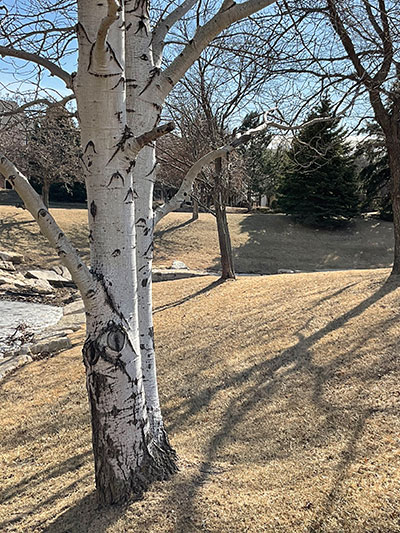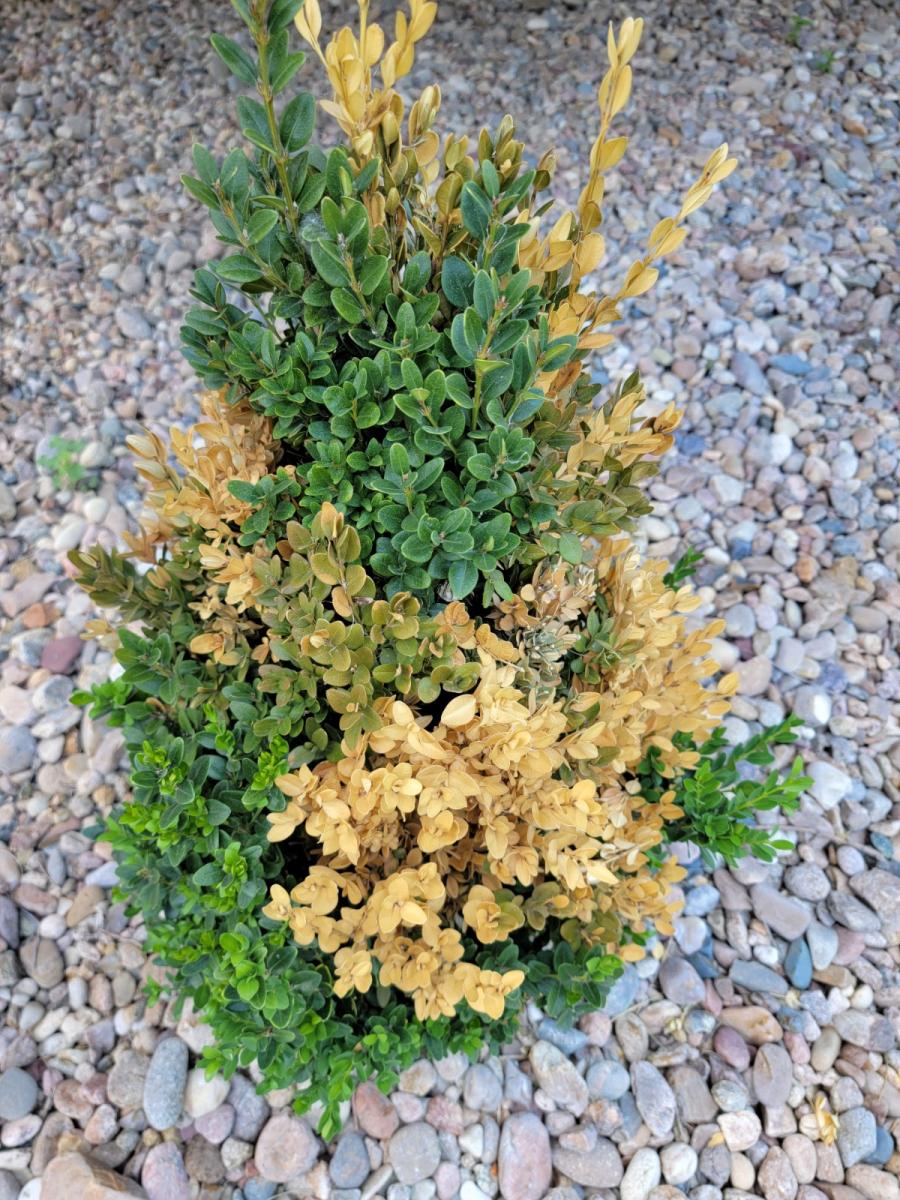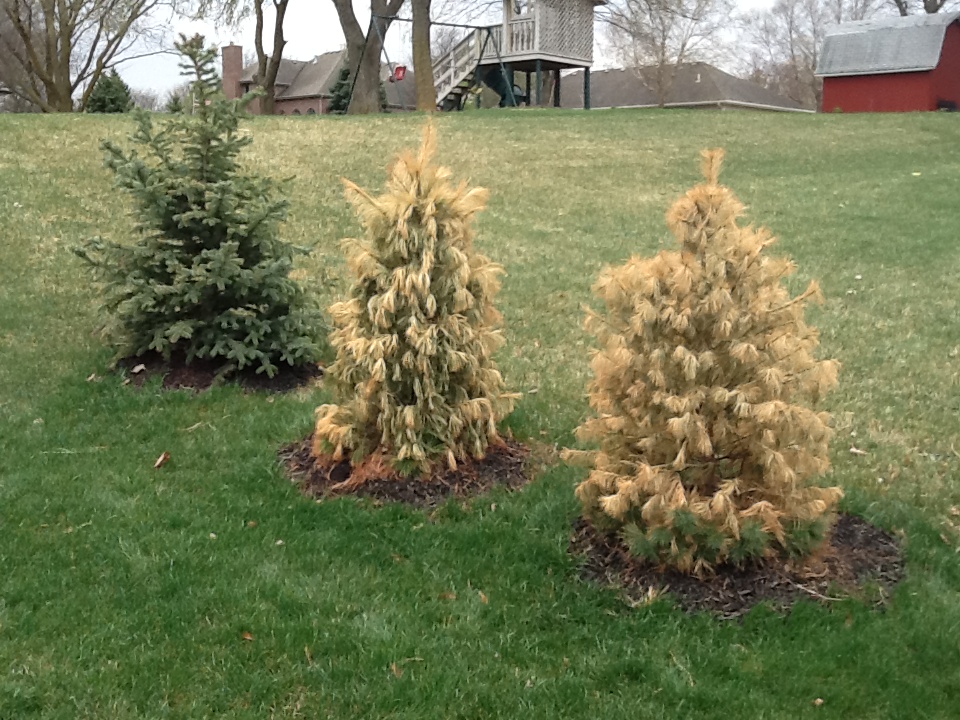
Most of this winter’s conditions have been abnormally warm and dry, and at times very windy. Lack of snow or rain is resulting in winter drought conditions for much of the state - for a look at current drought conditions, visit drought.unl.edu. In the Lincoln area, soil did not freeze until late December and only remained frozen for a few weeks, until approximately late January. In many areas, recent warm conditions have reduced or eliminated frozen soil.
A lack of snow cover or frozen soil allows continuing water evaporation, worsening dry soils. Wind pulls moisture out of plant tissues and is especially hard on evergreens. Unfrozen soil also allows air temperature fluctuations to transfer to the soil more easily than does frozen soil, which is potentially damaging tree and shrub roots.
This combination of dry, unfrozen soil could easily result in plant damage by spring both in woody plants, perennials and turf. The extended forecast for February predicts daytime temperatures in the 40s and 50s, so is it worthwhile to water now or will it set plants up for damage when freezing temperatures return? (Don’t think there won’t be freezes in the next 11 weeks before we reach our average last frost date.)
Time to Start Watering
The answer is yes, mid-winter watering is recommended if soils are not frozen and air temperatures are above 40º F. Water deeply for woody plants, moistening the top 12-18” of the soil, but water infrequently. One deep irrigation per month is sufficient. Focus on providing water from the trunk to the edge of the widest branch, also called the dripline, at a minimum.
But will watering cause tree buds or other tissues to lose winter hardiness early and make them more susceptible to damage from spring freezes? No, melting snow does not cause woody plants to lose winter hardiness and neither will winter irrigation. The initiation of spring growth is regulated by temperature, not water.
Spring growth will not begin until woody plants have reached a species-specific number of chilling hours, also known as the vernalization requirement. This is the number of hours that accumulate with temperatures between 32º and 45º F, beginning in fall. Temperatures below 32º F are ineffective at breaking down plant hormones responsible for bud dormancy, so these hours don’t count.
Temperatures above 60º F have a negative effect on vernalization and are subtracted from the accumulated chilling hours. Once a plant reaches its chilling hours in spring, then growth can begin when weather conditions are favorable for growth.
Recognizing & Managing Winter Damage on Trees & Shrubs Winter desiccation injury is often most severe on evergreens and broadleaf evergreens. Damage occurs when the amount of moisture lost through foliage is greater than can be replaced by roots from dry soil. Plant tissue dries out resulting in browning of foliage and dieback, which is often not seen until spring.
Winter desiccation injury is often most severe on evergreens and broadleaf evergreens. Damage occurs when the amount of moisture lost through foliage is greater than can be replaced by roots from dry soil. Plant tissue dries out resulting in browning of foliage and dieback, which is often not seen until spring.
Injury is found on the outer portion of the branches and is most severe on the side of the tree facing the wind or a source of radiated heat, such as a south or west-facing brick wall or street.
 If desiccation damage does appear in spring, don’t be in a hurry to prune out damaged tissue. While green needles may be brown, the buds on the branches may still be viable and will eventually open. If damage is not too severe and twigs are not killed, the area may eventually fill in. With evergreens, pruning cannot be done past where there is green leaf tissue. If this is necessary, consider replacing the plant with one better adapted to the site.
If desiccation damage does appear in spring, don’t be in a hurry to prune out damaged tissue. While green needles may be brown, the buds on the branches may still be viable and will eventually open. If damage is not too severe and twigs are not killed, the area may eventually fill in. With evergreens, pruning cannot be done past where there is green leaf tissue. If this is necessary, consider replacing the plant with one better adapted to the site.
Turfgrass
Dry conditions can also injure turfgrass. Desiccation injury is usually greatest on exposed or elevated areas where surface water runoff is greatest. It is also prevalent on poorly rooted turf that cannot take-up water from deeper in the soil profile.
If winter irrigation is used, only water when the soil is not frozen and air temperatures are above 40º F. The goal is to rehydrate plant crowns back to a survivable level and restore soil moisture at the surface. Avoid excessive quantities of water which may fill soil pores or runoff and present an icing hazard when cold temperatures return. Two irrigations, 0.5 inches of water each, per month should be sufficient.
Also avoid trafficking high value turf areas as winter drought, like summer drought, increases the risk of traffic injury.
To prevent crown hydration injury, avoid watering just before a sudden temperature drop is forecast, when the ground is frozen, or in low areas where water might collect and stand due to frozen soil or poor drainage.
Images
- Feature image - Dry winter conditions. Sarah Browning, Nebraska Extension
- Boxwood winter damage. Image used with permission from homeowner.
- White pine winter desiccation. Image used with permission from homeowner.